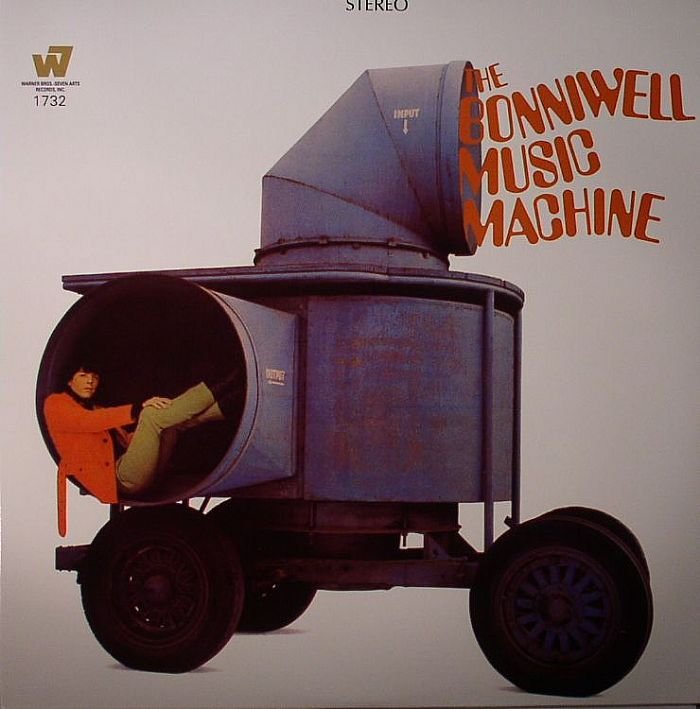That The Bonniwell Music Machine hadn’t yet been covered by the DeLorean Blog came to me as a huge surprise, for I can think of no other record in my collection that so deeply warrants a contextual analysis based on time. Plus, it’s the work of a great songwriter often overlooked by the masses, which is why whenever someone around me brings up garage rock or garage punk, I almost always namedrop BMM. The irony is that in 1968, they were marketed not for their lo-fi reworking of R&B tropes, but instead as purveyors of a clean, futuristic sound.
The record’s back cover states: “The Bonniwell Music Machine is ideally named, in fact, for they have fallen heir to a treasure chest of electronic techniques pioneered by such ancestors as The Beatles and The Beach Boys, and are pushing farther out into the frontiers of studio-produced music. The wild variations of electronic distortions, splicings, time lags, echoes, and dynamics control on this album are the most advanced products of sound engineering, recording and mixing available,” but in listening today, not one of these innovations stands out at such. In fact, they don’t even really stand out at all. Granted, I’m far from the world’s biggest audiophile — actually, my understanding of sound engineering, recording and mixing is novice at best — so the explanation could be that I’m not hearing the “variations in dynamics control” because I’m not 100 percent sure what to listen for from the start, but isn’t it also possible that collectively we’ve become so attuned to these technological tricks that we no longer notice them?
This concept need not be considered metaphysical in nature. Think about the evolution of television from black and white to color, from big screens to flat screens, the way our eyes have become acclimated to an HD picture. What was once new and complex is now simple and commonplace, even taken for granted. Yesterday’s electronic pop is today’s garage rock. In that sense, the steampunk contraption pictured on the front cover isn’t just a music machine… It’s also a time machine, if not a DeLorean then maybe the box in Primer (see: input/output design and the whole “garage” motif).
Appropriately, Sean Bonniwell’s songwriting boasted elements of past, present and future musical styles. Rooted in basic blues chord changes and a folk music background, he adopted the psychedelic melodies de jour while looking ahead to the progressive pomp of the coming years. As the back cover describes, “The compositions [he] has composed are specially suited to the development of electronic enrichments…” With the benefit of hindsight we can estimate that this is because, like many electronically enriched prog rock licks of the ’70s, Bonniwell’s riffs demonstrate that particular combination of technical prowess and panache. This can be heard across the board, but is especially evident on “Double Yellow Line,” with its dueling bass and guitar lines, and “Discrepancy,” which, deconstructed, sounds like two songs laid on top of each other. According to Bonniwell himself, “Discrepancy” is also the only BMM song that wasn’t definitely written, recorded, and arranged to be heard in mono. “Stereo weakens the coagulated force of the band and thus, the intended impact,” he explained. It’s an odd notion, especially considering all the aforementioned sonic enhancements they explored. Again, we return to the idea of temporal context.
I’ve already touched on how the band was promoted to the public in the 1960s and how they’ve been received in later years, but I think it’s also informative to examine how they were received back when they were active. An old article from the Minneapolis Tribune titled “Music Machine Upstages Blues Magoos” details one live performance: “Their musical experience showed … in Latin American and Near Easter overtones in several numbers, and they did some haunting things with an organ and a flute. Higher in pitch and more discordant that most modern music, their sound was startling in the huge arena. Even the wandering semi-bored teeny-boppers stopped wandering to listen.” Not to overextend the Back to the Future metaphor, but I can’t help compare the scene described here to Marty McFly covering “Johnny B. Goode” at the Enchantment Under the Sea dance. Just imagine it: a bunch of flower-patterned teens are meandering about when suddenly a gang of black-clad, one-gloved weirdoes shows up and starts barking poems while making unidentifiable noises with their instruments. It’s the perfect image.
Sadly, The Music Machine (as they were originally called) disassembled after the release of their debut album, Turn On. The Warner-released follow-up, The Bonniwell Music Machine, features the original lineup on several tracks, including the previously released singles “Double Yellow Line” and “Eagle Never Hunts the Fly,” but is for the most part a collection of songs recorded by varying rosters at different times and places. In fact, it was originally going to be called Odds And Ends, yet somehow this lack of cohesion takes nothing away from the album’s value (another example of temporal context?), and while Turn On might be a more complete work, it’s here that Bonniwell’s best work is collected. For God’s sake, “Eagle Never Hunts the Fly” essentially contains a hardcore breakdown… and it was first released in 1966! Need I say more?
